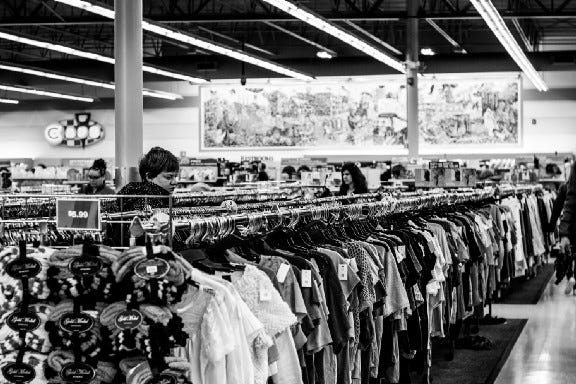Increase Sales by Creating Seamless Thrift Shopping Experiences
Seamless means simple and logical. Customers want to get in and out with as little hassle as possible.

Past a lot of hype about customer experience, there is one core truth. Customers want a seamless shopping experience. It doesn’t matter if it’s shopping online, at a department, grocery, or thrift store. Seamless means logical and simple. That’s the primary reason Amazon came up with the one-click purchase option. I have to admit being a willing victim of that deviously ingenious invention. That type of concept is repeated in a thousand ways in a retail store.
Almost every grocery store has milk in the back. Once someone puts refrigerated perishable items in their cart their subconscious clock is ticking. Check it out for yourself, next time you shop see if you prefer to get refrigerated items near the end of your shopping trip. Imagine if milk was right at the front door making it the first thing you picked up. Your shopping trip would be shorter, significantly so.
In big box stores, Women’s clothing has more prime real-estate than any other department. Well, it’s a lot more profitable than milk. Retailers win when women shop that department and women appreciate the convenience of having it upfront. Customers are conditioned, dare I say trained, to these conventions. Because they are so common they are part of a seamless shopping experience.
Thrift does best when well established traditional retail conventions are followed.
Thrift shoppers are a wonderful breed. They show up maybe wanting something specific, a toaster, or a broken-in pair of jeans. At the same time, they are more flexible in their purchases than they are at the grocery store. Knowing thrift stores live off of donated goods that vary every day they are not upset when there aren’t any good toasters on a specific day.
Making a thrift shop feel more like a traditional store makes the experience better. Women’s clothing should always be the first department inside the door. Items that tend to wind up a shopping trip, like furniture in the back.
A lady looking for size 12 Lee jeans, ideally finds them in the women’s area in the jeans section in the space devoted to size 12. If all of the size 12 jeans are clearly marked and nicely placed as a grouping she can see her choices for the day. She was thinking Lee but, wow, here is a great pair of Levi’s that will do the trick. Seamless = Sale.
Some “old school” thrift stores still merchandise with long runs of only the most general categories. Not seamless. Early in my thrift career I implemented more detailed categorization and sizing. Frankly, it was fairly controversial at the time. Sales jumped well in excess of the extra labor cost to operate a more carefully curated store. Customers came in more often as they knew they didn’t have to hunt all day for what they wanted. People spent more on each visit as they had time to find additional items. Everyone won.
Part of a well-curated store is making sure everything is in the right place. If that pair of women’s jeans is in the men’s section she will never ever find it. Even if it’s next door in the size 16 section she is unlikely to find it. Mis-categorized goods cost sales and reduce customer satisfaction. I believe a lot of great items that end up in outlet stores or salvage are there because they never had a real chance to sell. They were in the wrong place. Regular daily recovery is a core part of traditional retail as well as successful thrift stores.
I recently purchased shrimp for a shrimp boil and was quite pleased the Zatarain’s seasoning mix as well as the shrimp sauce were conveniently placed right with the shrimp. Seamless!
We don’t sell shrimp in thrift, but we do sell belts, scarves, ties, and sometimes socks. Sales jump when those obviously related items are right there, usually on an end display.
Accessories merchandised in the right spot, with quality choices also make customers and cash registers happy. One of my pet peeves is the necktie display. 90% of neckties should be salvaged or saved for Halloween. There are a few amazing ties donated every day. That other 10% are gems that will sell at a good price.
I have seldom seen anyone digging though decade out of style ties looking for that perfect one for the wedding they are going to next week. A former colleague of mine used to say that we were only as good as the worst item put on the floor. There is a seed of wisdom in that idea. Certainly, a small category like ties is only as good as the worst ones on display.
Thrift merchants that don’t think like thrift merchants will win in the coming years. There are so many online second-hand choices with more popping up every day. Physical stores have to stay at the top of their game. Thinking seamlessly every day will make a huge difference.
I am a thrift and retail business expert located near Chicago. Using my twenty plus years of retail and seven-plus years of thrift retail experience to help small businesses grow and succeed.
You can also find me on LinkedIn, Medium, and my thrift reseller blog The Thrifter.
You might also be interested in my Thrift Merchandising ebook on Amazon. It’s about how to merchandise thrift stores more like traditional stores. It’s free with a Kindle Unlimited membership.
Thanks for reading and Happy Thrifting!
Tim Gebauer




